Substrate under the finish coat is needed to equip a quality floor. There are several types of substrates that differ in material and properties. How to choose the lining material?
Varieties of substrates
The assortment of substrates for floor coverings is very wide. Produce them from various materials:
- Polyethylene foam. This is the most common variant of substrate under and other coatings due to availability.
- Foiled polyethylene. Used foil substrate for a parquet board, laminate and other coatings, requiring increased protection from moisture. The foil additionally protects the room from unnecessary noise and heat loss.
- Cork substrate is environmentally friendly material. Usually it is used for flooring of a parquet board.
- Rubber-cork material dampens vibrations from electrical appliances. It is convenient to use such a substrate for linoleum.
- Composite three-layer substrate for carpet or linoleum allows to ensure a constant height of the floor due to non-shrinking material.
The choice of the lining depends on the tasks. To ensure moisture resistance, foil polyethylene is used, and if environmental cleanliness is important, the cork material will be the optimal solution.
Substrate Functions
The importance of the substrate is often underestimated. Nevertheless, it performs the following functions:
- provides additional sound insulation and thermal insulation
- dampens vibration from electrical appliances, such as a washing machine
- creates excellent depreciation
- smoothes minor roughness of rough surface
The price of the substrate for laminate and other coatings differs depending on the properties of the material.
The substrate is a special damping material, the main task of which is to separate the laminate from the substrate. Thanks to him finishing Protects against moisture and shock noise. Moreover, the backing material provides the best thermal insulation of the room. Which substrate is better for laminate? In this article we will talk about varieties of dampers, as well as the pros and cons of modern decks.
The main tasks of the substrate
The flooring plays one of the most important roles in the repair of the room. In this case, laminate and parquet are placed only on a previously prepared basis. That's why the choice of flooring must be taken with all seriousness. The substrate performs a variety of functions that improve the characteristics of the floor covering:
- Soundproofing. Laminate, like many synthetic materials, has one significant drawback: while walking on the surface an unpleasant loud sound is produced, which gives the artificiality of the coating. Therefore, to buffer the impact noise between the lamellas and the screed, a buffer is placed in the form of a special litter;
- Leveling properties. Since it is almost impossible to make a perfectly flat screed, part of the "worries" takes on an intermediate flooring;
- Moisture insulation. Increased humidity affects the laminated coating negatively, so it can not be mounted on a wet screed. To ensure sufficient waterproofing, use special moisture resistant substrates that protect the lamellas from destruction;
- Thermal insulation. Laminate itself is a good thermal insulator, but this is not always enough to ensure effective heat preservation in the room. Reduce the level of "leakage" of heat will help the damper, which in combination with the finish coat will give double protection from the cold.
Lining Requirements

To date, manufacturers of building materials offer consumers a variety of substrates, which should ensure the durability of the coating. At the same time, savings on the damper can lead to very negative consequences, up to the destruction of the locking systems and deformation of the lamellas.
What is better to use a substrate for laminate? First of all, it must be of high quality, so the material must meet certain requirements:
- The floor should "breathe", for this reason it is desirable that the structure of the flooring is porous, this will contribute to the micro-ventilation of the floor;
- The material must provide good sound and heat insulation;
- Litter should reduce the load on the lock joints slats.
The main types of dampers
Which substrate should I use for laminate? To determine the choice, it is worth considering the main types of materials, as well as the pros and cons of their application. Only then can anyone determine for themselves the best option underlayer.
All litter are classified according to the following criteria:
- Material of manufacture. As raw materials for the production of damper are used:
- Natural additives - wood pellets and pressed chips;
- Synthesized additives - polystyrene, polypropylene, polyethylene.
- Method of manufacture.
In this case, the pluses and minuses of the substrate under the laminate have each of these types. And to make the right choice in favor of this or that type of coverage, it is worthwhile to evaluate the advantages and disadvantages of each one individually.
Izolonovaja litter

- does not react with chemicals;
- is not a favorable breeding ground for bacteria and mold;
- has excellent noise and thermal insulation;
- it has a vapor permeability, so it can be installed in rooms with high humidity;
- cheap material.
At the same time, many consumer testimonials indicate the presence of some flaws in the flooring.
- easily torn and deformed;
- under the influence of a serious load can be thinned, which will lead to the appearance of backlashes between the lamellas and the base.
Polystyrene flooring
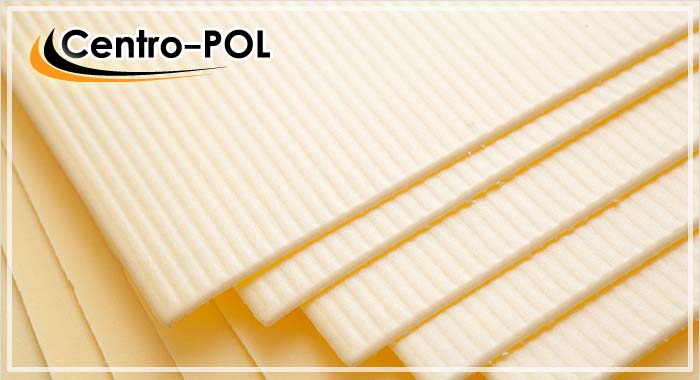
The litter consists of two layers: foil and polystyrene. In comparison with the insulating layer has the best technical characteristics.
- It is not so quickly thinned under mechanical stress;
- Eliminates up to 70% of noise;
- Protects the coating from shock vibration.
- The material is quite heavily decomposed, so mounting it is very problematic;
- It is worth more than isolon.
Fiberglass flooring
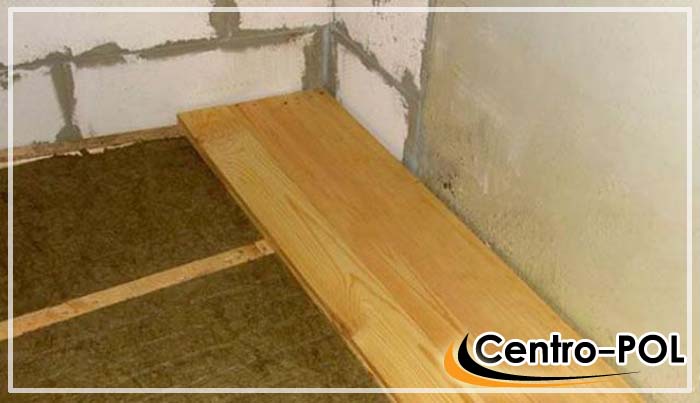
The damper is an environmentally friendly material, so it can easily be stacked even in children's rooms. Glass fiber can be used for installation on concrete and wooden floors.
- does not contain toxic substances;
- only elastic deformation;
- it is mounted immediately on the roughing base without any intermediate layers;
- has good sound insulation performance.
- used for laying slats, the thickness of which does not exceed 5-7 mm;
- quite expensive material.
Cork slabs

What substrate should I choose for a laminate so that it is strong? For these purposes, it is best to use a lining of pressed oak bark granules.
- it does not crumple and can last more than 100 years;
- a wonderful heat and sound insulator;
- very strong, therefore withstands a significant point load.
- not suitable for installation in rooms with a high humidity level;
- like cellulose, it is a favorable breeding medium for mold;
- it is used mainly for laying on a wooden base.
Bituminous cork damper
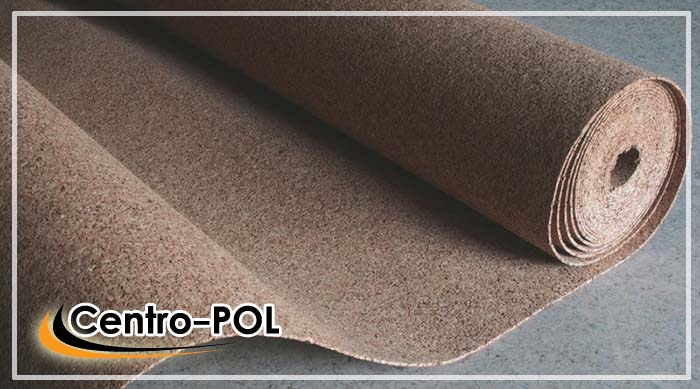
This kind of material is produced on the basis of kraft paper with some bitumen addition.
- well absorbs noise;
- prevents penetration of moisture;
- ensures the micro-ventilation of the coating;
- has leveling properties.
- because of the bitumen content is a fire hazardous material, therefore it is not used in private dwellings;
- one of the most expensive intermediate decks.
Composite materials
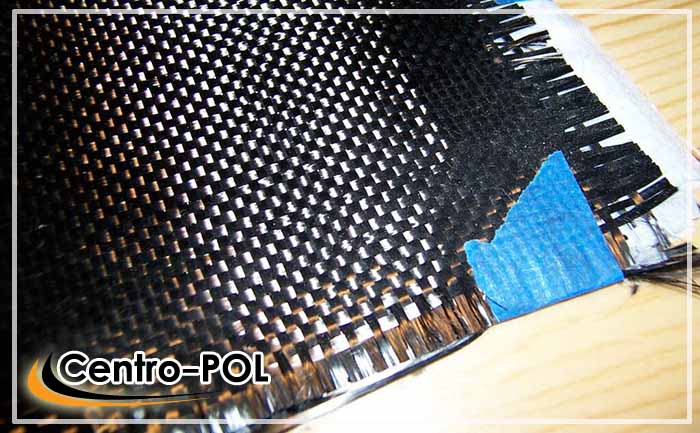
- Special membranes provide good moisture insulation;
- Absorbs transit noise;
- Provide good thermal insulation, suitable for the "warm floor" system.
- High price.
How to choose a substrate?
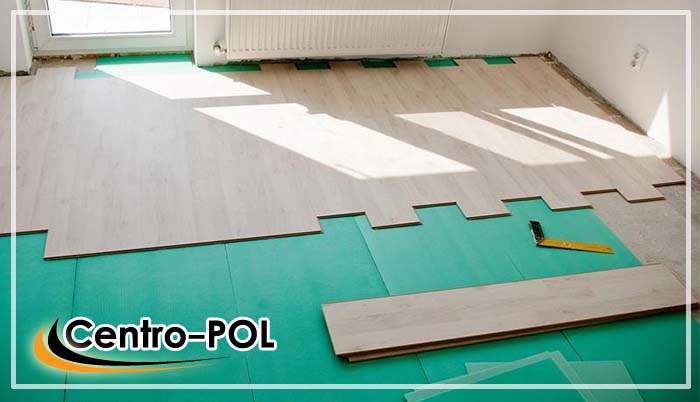
The best substrate under the laminate is the one that corresponds to the thickness of the laminated boards. When choosing a damper, you should first pay attention to its thickness. Under the laminate, with a thickness of 4 to 6 mm, experts recommend using a 2 mm-lining.
Tip: For boards with a thickness of 7 to 12 mm, it is advisable to use 4 mm-substrates. A thicker buffer layer will spring, which will lead to loosening of the locking system on the lamellae. After a while this will affect the quality of the panel connection.
Which substrate will be of high quality? In order to finally answer this question, it is necessary to determine the selection criteria, according to which each consumer can make an optimal decision for himself:
- Measure the cost of the laminate and damper layer. Expensive composite litter does not make sense to put a low-quality laminate, it does not affect its technical characteristics. That's why for budgetary option topcoats apply special litter is not recommended;
- Before you make your choice, decide on the goals of stacking the damper layer, what functions it should perform. Often people overpay, choosing best coverage, half of the properties of which remains unused;
- Estimate the area of the base. For large rooms it is desirable to use roll-up substrates, and for small-sized ones - tiled. This will significantly reduce the time of preparatory work.
conclusions
The final choice of damping material will depend on the financial capabilities of the consumer, as well as the features of the premises where the repair work. It is worth considering that each individual situation needs its technical solution:
- For rooms with a high level of humidity, either synthetic materials or natural, but with special additives, are suitable;
- For multi-storey panel houses it is desirable to purchase pads with good noise insulation;
- For cork floors, cork or coniferous decking is ideal;
- For the "warm floor" system, it is best to use isolone litter.
Before you give preference to a particular kind of material, it is worth to evaluate all its pros and cons. Then the chosen damper base will ensure a sufficient level of wear resistance of the finish coat.
If you decide to make a bed as a floor covering, you will necessarily come across the issue of choosing a substrate. What is it, what is it for when installing laminated panels and what is the better substrate for the laminate? It is easy to learn about this by carefully reading this material to the end.
What is the substrate for?
The answer to this question lies in the laminate itself. First of all, it is a product made on the basis of waste from the woodworking industry. Shredded sawdust and dust are impregnated with epoxy compounds and pressed under high pressure in a mold.
On top of the finished panel, a decorative laminated layer is applied, which repeats the wood texture and is covered with a protective impact-resistant varnish. Bottom glued protective polymer layer, which should protect the laminate from moisture and mechanical stress. In this case, it is worth remembering that this is all the same tree and it does not tolerate the effects of moisture.

On the four sides of the laminated panel there are locks for fastening adjacent boards. Lay laminate should only be on the carefully leveled surface of the existing floor. Usually it is cement-sand or concrete screed.
It is important to know! The difference in the base of the floor should not exceed 1 mm per 2 m of the runners.
Lay the laminate on bare concrete can not. The smallest gaps between the board and the screed lead to the fact that when walking flooring will bend and knock on the screed. This will lead to premature wear of the lower protective layer of the laminate. The moisture can get inside the board, which will cause it to swell and deform.

To prevent this from happening, a laminate is laid under the laminate. The substrate for the laminate plays the role of a shock absorber and to a certain extent increases the sound insulation of the floor. In addition, according to the technology of laying the floor covering on the concrete foundation under the laminate, a vapor barrier layer is necessary. Some substrates are excellent for this task.
What substrate should I choose for a laminate on a concrete floor?
Modern market building materials has a wide choice of substrates under the laminate. The most common and are the following substrates:
- Natural cork
- Foamed polyethylene - isolon
- • Foamed polystyrene
- Heat and sound insulation wood boards
Before choosing a substrate for a laminate, let's look at each option separately and identify its positive and negative sides. Based on this, you can determine what kind of substrate under the laminate on the concrete floor for your apartment or house.
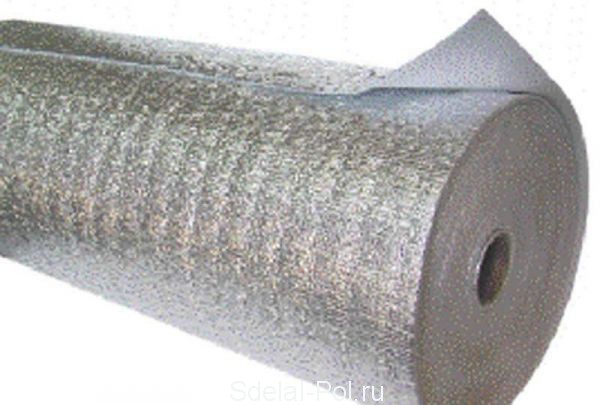
The cork substrate is made of natural wood of the same name and has very high characteristics for sound insulation and thermal protection. It practically does not shrink when the load is applied to the floor for a long time. This is very important, because the sagged substrate significantly increases the load on the laminate locks.
Over time, they can disperse. The cork substrate will never allow this. Produce a cork substrate in the form of rolls or plates. The thickness of the substrate under the laminate of the plug is 2-4 mm. However, the cork has also negative aspects:
- This material is very expensive
- Before laying a substrate under the laminate on a concrete floor, it is necessary to lay a vapor barrier layer from a polyethylene film
Isolon is made of foamed polyethylene. Such material is the cheapest in the list of modern substrates. It is produced in the form of rolls and has a thickness of 2-3 mm. It is easy to lay and cut, and to join the strips of the substrate, regular scotch is used.
On sale there is an isolone laminated with one or two sides of aluminum foil. This significantly increases the thermal insulation of the floor. Such a substrate is recommended to be laid under underfloor heating systems, which are then covered with a laminate. Isolon simultaneously acts as a vapor barrier for concrete base, which is not affected by fungi.
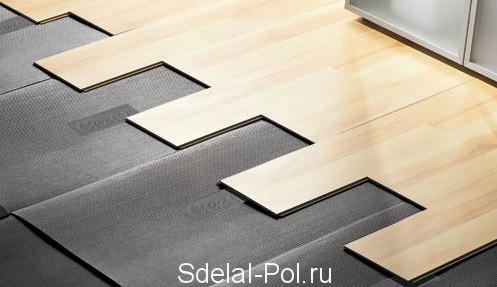
The disadvantages of such a substrate are:
- • Thin porous material quickly deforms and shrinks
- The unstable texture of the isolon is very easily broken at mechanical loads
Foamed polystyrene is produced in the form of plates or sheets with a size of 1 x 1 m. The sheet substrate for polystyrene laminate is optimal if viewed from the "price-quality" view. It has all the positive characteristics of isolone, but it is strong enough and does not shrink during prolonged loads.
At a thickness of 3 mm, the polystyrene substrate will reliably protect the laminate from noise from neighbors and shock loads when walking. In addition, it has good thermal insulation.
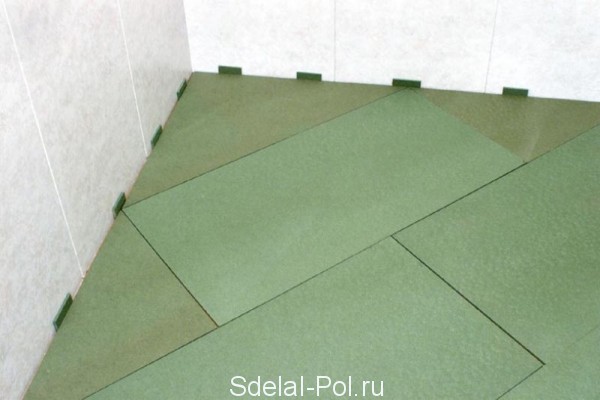
Heat-soundproof wood boards are made of natural material, and contain absolutely no chemical impurities. The dense material is produced from waste wood industry in the form of sheets of greenish color. Wood substrate under the laminate 7 mm or 5 mm thick is recommended for use in private houses with wooden flooring, where the energy saving issue is acute.
Such a substrate will level out minor defects of the existing floor. It can suppress noise up to 21 dB and can withstand the pressure on the laminate locks of 20 ton / m2. By thermal conductivity, it approaches soft heaters, such as mineral wool. From the minuses:
- High price
- Requires a vapor barrier before laying
See how the substrate under the laminate is laid on the video presented in this article. We hope that this material will help you make the right choice of substrate under the laminate.
Laminate is one of the most popular kinds of flooring, having a long enough service life, durability, simple laying technology, beautiful appearance. But the surface on which it will be laid, requires special preparation. One of its stages is laying on the base of the substrate floor.
Purpose of the substrate under the laminate
The use of the substrate is due to the structure of the laminate. It is manufactured using high-tech equipment in the form of panel panels consisting of several layers. They are formed by pressing wood dust and are coated on both sides with paper layers, which are impregnated with special impregnation. The upper part of the material has a laminated coating. The underside of the panels is air-and liquid-permeable.
The substrate has the following functions:
- Smoothing of small (up to 2 mm) height differences and defects of the floor surface, on which the laminate is laid;
- Elimination of vibration caused by the presence of an air gap between the floor surface and the laminate, which can lead to backlash and damage to the coating due to the gradual loosening of the locks;
- Provision of waterproofing, preventing adverse effects of moisture on the back of the panel;
- Noise and heat insulation of the room.
Selecting a substrate for a laminate
When choosing the most suitable substrate, the properties of the substrate are taken into account, on the surface of which it is planned to lay the laminate. If a waterproof and waterproof material should be placed on a concrete floor with capillaries capable of absorbing moisture, then a greener natural cork substrate or glass fiber can be used on the wooden floor.
The choice of substrates manufactured by manufacturers is quite wide. They are made of synthetic, natural and semi-natural materials, which differ in their properties, for example, moisture resistance, strength and a number of other characteristics. The substrate can have a thickness of from 2 to 5 mm, depending on the kind of floor base, the flatness of its surface and the thickness of the laminate.
Cork substrate
The cork substrate is a natural, environmentally friendly material for the production of which the technology of pressure pressing under the crushed crust of cork that grows in the northern regions of Africa and southwestern Europe is used. The resulting product does not contain any chemical ingredients. The substrate is produced in the form of rolls or plates of different thicknesses.
Advantages of the cork substrate:
- After stacking it does not crumble, there is practically no pressing.
- It is not affected by fungi and other microorganisms.
- Provides high sound and heat insulation, without losing their efficiency with continued use.
The disadvantages of the material are low moisture resistance, increased complexity of stacking compared to other kinds of substrates, expensive price. This type of substrate is most suitable for laying a laminate on wooden floors.
The interaction of wood and cork is optimal for a number of reasons:
- the absence of crease at the cork substrate allows not to worry because of the insufficiently flat surface of the wooden coating;
- both materials are vapor-permeable, but they are not resistant to high humidity, so they are not recommended for use in kitchens or bathrooms.
Cork substrate is better to use when laying expensive types of laminate, which have high quality.
Substrate, made of fiberglass
The glass wool substrate can be stacked on both the wood and concrete surface. It has a thickness of 5-7 mm. and practically has no shortcomings.
Benefits of the material:
- Ecological compatibility.
- During operation there is no creasing, squeezing or deformation. When laying the substrate, no intermediate materials are required.
- Provides good sound insulation.
- There are no chemicals and glue in the product.
Foamed polyethylene substrate
This type of substrate is the most commonly used due to the inexpensive cost. Foamed polyethylene is a foam polyethylene. According to the manufacturing method, it is physically crosslinked (PPE-FS grade), significantly superior in cross-link strength chemically and non-crosslinked types of polyethylene PPE-XC and NPE.
Advantages of foamed polyethylene substrate:
- High resistance to moisture and vapor tightness.
- It is not affected by microorganisms, including fungi.
- Has a chemical neutrality to almost all types of building materials.
- It is a good noise and heat insulator.
- Provides a sufficient level of depreciation.
- Has a light weight, resistant to rodents.
- It is characterized by inexpensive cost, easy installation, long service life.
This material also has disadvantages:
- Lit with the release of very toxic substances.
- It is able to cake under prolonged exposure to a load, for example, under heavy furniture.
- Easy enough to break.
According to experts, polyethylene foam is better used for concrete floors. The highest insulation is provided by a foamed polyester foil or a polyurethane film of a polyester film.
Polystyrene substrate
This type of substrate is superior in strength to the previous form. The material is also called "isoshum", it consists of two layers: foamed polystyrene and aluminum foil. Polystyrene has the same properties as foam polyethylene, at the same time they are more pronounced. It has a better sound insulation, sound absorption can reach 70%. The pressure of considerable weight is accompanied by its pressing, but this material is less characteristic of caking. It is more dense, due to the increased strength it is more difficult to tear. The laying of the polystyrene substrate is less simple, has its own difficulties. When used for a concrete floor, it provides additional thermal insulation. The dimensions of sheets of polystyrene - 1x1 m.
Which substrate under the laminate is best suited for your base, taking into account its practicality and durability of the laminated coating, about these subtleties and talk in this article. Laminate, as a building and finishing material, is now at the peak of popularity. After all, it is sufficiently durable and perfectly suited as a floor covering.
Moreover - the laying of laminate floor is possible even for those who are inexperienced in these matters and have not encountered this material before. What is there to say - laminate has several advantages over other materials.
Why do we need substrates and what are the requirements for them?
It must be remembered that in order to make the laminate floor really beautiful, before laying this material it is necessary to achieve an almost perfectly flat surface of the base, on which the laminate will be laid. It may seem that there is no easier task. Those. it is enough only to achieve an even surface of the base and begin to lay the laminate floating method, in which a "monolithic board" is formed, not rigidly connected with the base.
However, not everything is so simple. Try just to walk on such a floor in shoes with heels, as you can hear a loud clatter, as if a man, not a horse, had passed. The lifetime of such a coating is not long, after 2-3 months in the joints of the laminate there will be a backlash, and then the floor will simply begin to bend and knock on the base.
To prevent such an incident, a substrate is usually placed under the laminate, the thickness of which lies within the range of 2-4 mm. The substrate is designed to smooth out the unevenness of the base, to be a kind of shock absorber between the laminate and the screed, and also to suppress the noises that begin to appear when walking across the laminate.
To date, most of the substrates under the laminate are porous and are afraid of moisture. The only exception is Tuplex and bituminous mastic. If the substrate is laid on plywood sheets, then there is no need for additional moisture insulation. If the parquet board and the laminate are laid on the screed, then due to the temperature difference, the condensation begins to appear on the screed. In this case, it is strongly recommended to place a PVC film under the substrate, a thickness of at least 0.2 mm. To determine which substrate is best for a laminate, consider specifications, as well as advantages and disadvantages of each type of substrates.
Substrate of expanded polyethylene
Foamed polyethylene is a fragile material and if it is for a long time under load, it has the property of being pressed. Foamed polyethylene is sold in rolls. In general, this material is considered the cheapest for the substrate and very easily tearing.
After about 10 years, the foamed polyethylene begins to disintegrate gradually, and from it no longer material for the substrate is obtained, but a powder that does not hold moisture well and allows heat to pass through. And if you add here the fact that these rolls could be stored in warehouses for 2 years, waiting for their buyer, the remaining period of his service is even less. Choosing foamed polyethylene as a substrate material, one must pay attention to its density. If the density is good, then its quality at the height and the service life will be long.
As with any material, this type of substrate has both advantages and disadvantages.
+ The advantages of foamed polyethylene include the following:
- it is moisture resistant;
- has good noise insulation characteristics;
- fits easily and quickly;
- the strips of foamed polyethylene are joined together by an adhesive tape;
- cheap.
- However, this material is not without drawbacks. They include:
- weak mechanical strength;
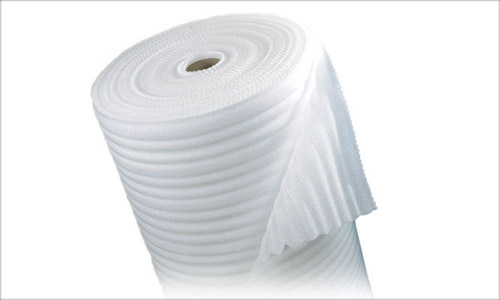
Roll of foam polyethylene.
Polystyrene as a substrate
Polystyrene has almost the same characteristics as polyethylene, but some parameters are many times better. The thickness of polystyrene is 3 mm and it is usually used as a substrate in those houses where the floor covering should have increased thermal insulation characteristics, for example in a private house. Polystyrene is sold in slabs, the size of which is a meter-by-meter. In a pack, usually 10 sheets of polystyrene.
In some cases, the polystyrene substrate has 2 layers. The first is polystyrene, and the second is aluminum foil. These layers are interconnected. In the process of laying, you must ensure that the foil is always on top. The joining of the sheets, in this case, is carried out by an adhesive tape from the staniol.
+ The merits of polystyrene include the following:
- it is moisture resistant;
- stack it easily and quickly;
- has good sound-absorbing and noise-absorbing properties.
- However, there are also the following disadvantages:
- if you apply excessive force to polystyrene, then it can be easily broken;
- at high loads, polystyrene is simply compressed and loses its characteristics.
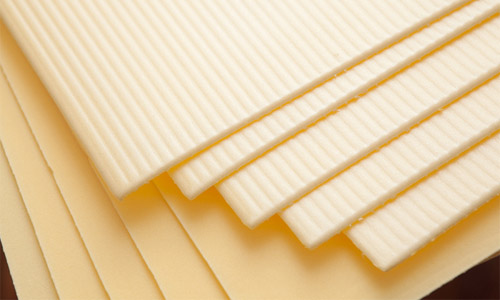
Substrate of polystyrene. Photo - kinplast.ru
Cork substrates
Such substrates are usually made from crumbs of cork wood, pressing them. This is environmentally friendly material, because there are no harmful components in it. Apparently, for this reason, such a substrate material is the most expensive among all known. But, being under the laminate, such a substrate is not compressed, and its sound-proof and heat-insulating characteristics are some of the best. Cork substrates can be sold both in the form of slabs and in the form of rolls, which allows you to reduce costs while purchasing this material and thereby save money.
+ Its advantages include:
- easy laying;
- good thermal insulation characteristics;
- environmental friendliness.
- However, it has the following drawbacks:
- the increased moisture for it is fatal, from it this material simply begins to crumble;
- the cost of the cork substrate may be high for some.
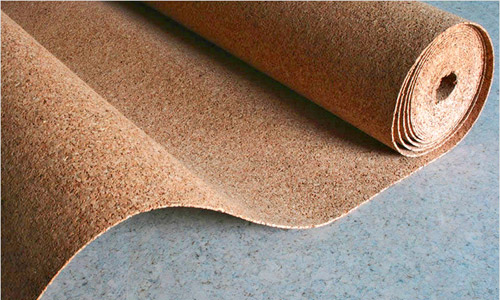
Substrate of pressed cork cork.
Rubber cork substrate
It is a mixture of artificial rubber and granular cork. According to some data, this material is several times better than the cork substrate in terms of noise insulation.
Bitumen-cork substrate
To present this material, it is enough to look at the Finnish material Parkolag from ICOPAL, the basis of which consists of kraft paper with impregnation of bitumen and the subsequent pouring of cork. This material should be laid cork peresypkoy down. So you can ensure micro ventilation under the substrate layer. In other words, this layer does not allow the formation of moisture. If such a substrate is used, then no additional waterproofing is necessary.
- See the material \u003e\u003e We select and lay the cork substrate under the laminate
Tuplex
It is a composite material, a thickness of at least 3 mm, which is made in France. Structurally it has 2 layers of PVC film, between which lie granular polystyrene. All this is covered with high-density polyethylene, which is designed for heavy loads and protects the laminate from moisture and dirt. The lower layer is also covered with polyethylene, but not so strong. But there are a lot of micro-holes in it, which let the moisture into the space filled with granular polystyrene.
It's pretty good material, which perfectly absorbs noise. Its stowage is fast and it can be used for organizing warm floors. Dock it only on one side, using a special overlap, which is applied to the special glue. This material is not subject to deformation, but is very afraid of high humidity.
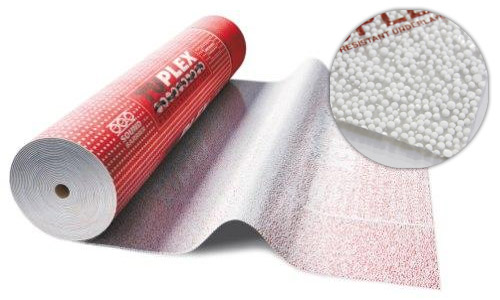
Substrate Tuplex.
Substrate based on bitumen
Despite the fact that this material can be called new on the Russian construction market, however, its active promotion has already begun. Its advantages include heat, noise and moisture insulation. All this, of course, is good, but it has one, but very serious drawback, which is that the bituminous mastic that underlies this substrate is the "hotbed" of formaldehyde. That's why this material is banned in many countries. It is interesting that our domestic producers are silent about this fact.
Which substrate is best for a laminate?
So, how to determine what substrate under the laminate is better to use and what parameters to pay the first attention. As you can see, there is currently no shortage of substrates under the laminate and is not expected. Maybe that's why it's not easy to decide the choice of podzhoda. So, for the right choice The following parameters must be taken into account:
- simplicity of its laying
- long service life
- not too high price with good quality
With regard to such a parameter as the thickness of the substrate, here, in order to avoid unnecessary cushioning and deflection of the sent fabric, experts recommend using substrates with a thickness of no more than 2-3 mm.
It is also necessary to know that a high-quality substrate, as an intermediate material, can increase the service life of the laminate. Whatever modification the component composition of the laminate panel would have, whether it will include polymer additives or include fiberboard or MDF, in any case this floor covering can be referred to wooden floor. Which in turn means that it is necessary for it to provide certain laying conditions, which depend on the substrate.
